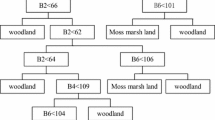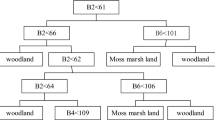Abstract
The loess plateau in China has faced severe soil erosion and runoff. Check-dams are effective measures for soil and water conservation; concomitantly check-dam planning and construction urgently require current land use maps. Remote sensing technique plays a key role in achieving up-to-date land use maps. However, limited by the impact of hilly and gully terrain in the loess plateau, commonly used classifier for remote sensing data cannot achieve satisfactory results. In this paper, HongShiMao watershed in the loess plateau was chosen as the study area. Decision tree classifier (DTC) based on a genetic algorithm (GA) was applied to the land use classification automatically. Compared with the results by iterative self-organizing data analysis technique (ISODATA), GA-based DTC had much better results. Its total accuracy was 83.2% with a Kappa coefficient 0.807. The results also showed that most part of the study area belonged to the barren land with sparse grass or crop cover that attributed to the soil erosion and runoff.




Similar content being viewed by others
Explore related subjects
Discover the latest articles, news and stories from top researchers in related subjects.References
Breiman L, Friedman JH, Olshen RA, Stone CJ (1984) Classification and regression trees. Chapman & Hall, New York
Brumby SP, Theiler J, Bloch JJ, Harvey NR, Perkins S, Szymanski JJ, Young AC (2002) Evolving land cover classification algorithms for multi-spectral and multi-temporal imagery. Proc SPIE 4480, pp 120–129
DeFries RS, Hansen MC, Townshend JRG, Sohlberg RS (1998) Global land cover classifications at 8 km spatial resolution: the use of training data derived from Landsat imagery in decision tree classifiers. Int J Remote Sens 19:3141–3168
DeFries RS, Townshend JRG (1994) Global land cover: comparison of groundbased datasets to classifications with AVHRR data. In: Environmental remote sensing from regional to global scales. Wiley, Chichester
De-Merckt TV (1993) Decision trees in numerical attribute spaces. In: Proceedings of the 13th international joint conference on artificial intelligence, pp 1016–1021
Dimitris K, Christos P (2006) Analyzing student performance in distance learning with genetic algorithms and decision trees. Appl Artif Intell 20(8):655–674
Friedl MA, Brodley CE (1997) Decision tree classification of land cover from remotely sensed data. Remote Sens Environ 61:399–409
Gelfand SB, Ravishankar CS, Delp EJ (1991) An iterative growing and pruning algorithm for classification tree design. IEEE Trans Pattern Anal Mach Intell 13:163–174
Giacinto G, Roli F (1997) Ensembles of neural networks for soft classification of remote sensing images. Proc of the European symposium on intelligent techniques Bari, Italy, pp 166–170
Llorà X, Garrell JM (2001) Evolution of decision trees. Proceeding of the fourth catalan conference on artificial inteligence (CCIA’2001), ACIA Press
Mitchell T (1997) Machine learning. McGraw Hill, New York
Pal M, Mather PM (2003) An assessment of the effectiveness of decision tree methods for land cover classification. Remote Sens Environ 86:554–565
Palaniappan K, Zhu F, Zhuang X, Zhao Y, Blanchard A (2000) Enhanced binary tree genetic algorithm for automatic land cover classification. IEEE 2000 international geoscience and remote sensing symposium, pp 688–692
Papagelis A, Kalles D (2001) Breeding decision trees using evolutionary techniques. Proceedings of the eighteenth international conference on machine learning, Morgan Kaufmann, San Francisco, June 28–July 01, pp 93–400
Quinlan R (1986) Induction of decision trees. Mach Learn 1(1):81–106
Quinlan R (1993) C4.5: programs for machine learning. Morgan Kaufmann, San Francisco
Shi Z, Wang RC, Huang MX, Landgraf D (2002) Detection of coastal saline land uses with multi-temporal Landsat images in Shangyu city, China. Environ Manage 30(1):142–150
Szymanski JP, Brumby SP, Pope P, Eads DR, Esch-Mosher D, Galassi M, Harvey N R, McCulloch HDW, Perkins SJ, Porter R, Theiler J, Young AC, Bloch JJ, David N (2002) Feature extraction from multiple data sources using genetic programming. Proc SPIE 4725, pp 338–345
Townshend JRG, Justice CO, Li W, Gurney C, McManus J (1991) Global land cover classification by remote sensing: present capabilities and future possibilities. Remote Sens Environ 35:243–256
Acknowledgments
This research is partially supported by the National Natural Science Foundation Project No. 40471103, the Key Project of National Natural Science Foundation No. 30590374, and the Opening Foundation Project No.2005406311 of State Key Laboratory of Hydrology-Water Resources and Hydraulic Engineering, Hohai University, China. Special thanks to Dr. Jiaping Wu of Zhejiang University and Dr. Minghua Zhang of University of California, Davis, for the help in revising the English expression.
Author information
Authors and Affiliations
Corresponding author
Rights and permissions
About this article
Cite this article
Huang, M., Gong, J., Shi, Z. et al. Genetic algorithm-based decision tree classifier for remote sensing mapping with SPOT-5 data in the HongShiMao watershed of the loess plateau, China. Neural Comput & Applic 16, 513–517 (2007). https://doi.org/10.1007/s00521-007-0104-z
Received:
Accepted:
Published:
Issue Date:
DOI: https://doi.org/10.1007/s00521-007-0104-z




